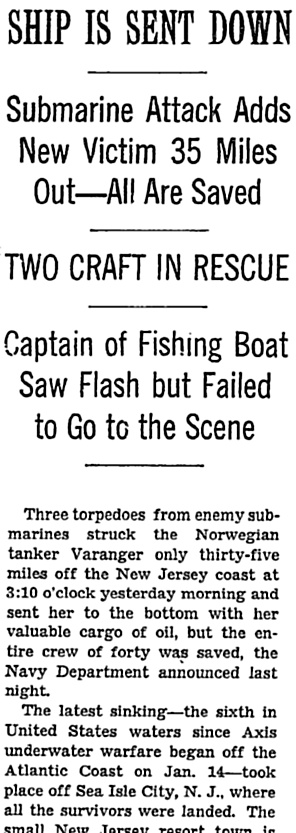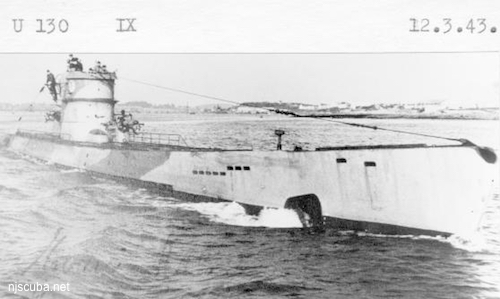Varanger

- Type:
- shipwreck, tanker, Norway
- Name:
- A peninsula in north-east Norway ( a cold place )
also, an old Scandinavian term for "Viking" - Built:
- 1925, Netherlands
- Specs:
- ( 470 x 60 ft ) 9305 gross tons, 40 crew
- Sunk:
- Sunday January 25, 1942
torpedoed by U-130 - no casualties - Depth:
- 140 ft
upright, partially intact, but heavily damaged by torpedoes

Varanger departed Curacao for New York with 12 750 tons fuel oil on Jan. 16-1942. On Jan. 25 ( at 03:00 according to a journal excerpt ) she was torpedoed by U-130 (Kals), 38 58N 74 06W ( about 28 n. miles southeast of Atlantic City, N. J. ) She was hit by 3 torpedoes and broke in three. The 1st torpedo struck on the port side between the foremast and the bridge where 2nd mate Wilhelmsen, the helmsman, Ordinary Seaman Brevik, and the lookout, Able Seaman Karlsen, were on duty. The explosion destroyed the port amidships lifeboat and rendered the radio useless. Her engine was stopped and all secret codebooks thrown overboard. The starboard amidships lifeboat and the aft starboard motorboat were ordered launched, and the former was on the water but the latter was only lowered halfway when about 5 minutes after the 1st torpedo had struck a 2nd torpedo hit between the aft mast and the poop. A couple of minutes later, after everyone had gotten off and behind the ship, which at that time had started to sink, a 3rd torpedo set her on fire. The front part stayed above water ( the attack happened close to land in about 140 ft. of water, ) while the other 2 parts sank.
All 40 ( 2 of whom were American citizens ) survived and as the U-boat surfaced they started to row westwards. The motorboat later took the lifeboat in tow. After about 6 hours they encountered 2 fishing vessels which towed the lifeboats to the Coast Guard Station at Sea Island Inlet, N.J. with arrival there at 12:45.
A report from Lieutenant Gilbert L. Countryman, U.S.N.R. to Commandant Fourth Naval District, via Commander Inshore Patrol dated Jan. 25-1942 ( based on survivors' statements ) says that Varanger had departed Coco Solo on Jan. 16, and was about 30 miles offshore on a course toward Barnegat ( 38 58N 74 06W ) when the first torpedo hit amidships on the port side at 03:10, destroying the radio equipment, closing hatches, blowing in plates, rendering the 4" gun inoperative and destroying 2 of the 4 lifeboats. As Varanger began to list and sink the crew crawled through holes blown in the plates to get out. The 2 remaining boats were launched and the men in the water were picked up. Each member of the crew wore an "Easco" lifejacket light ( electric, waterproof ) which enabled the boats to sight them easily in the water.
The 2nd torpedo, from another U-boat ( incorrect? ) hit on the port side at 03:17 and destroyed the engine room; all men were off the ship by then. At 03:22 a U-boat surfaced about 1 mile to shore while another came in close and fired a torpedo which hit forward on the port side, whereupon the ship sank rapidly. At that time the 2 lifeboats were headed toward Ocean City. A plane was heard in the air but not seen. Fishing vessels towed them to shore, and the men were taken to Townsend Inlet. No one was seriously injured, though they all suffered from shock and exposure, some had minor lacerations and bruises. 1st Mate Arnfinn Krokeide had possible fractured ribs from having been thrown to the deck in the first explosion, though a civilian doctor in attendance was of the opinion that it was a severe bruise and not a fracture ( excerpt from the ship's journal states he was admitted to a hospital in Philadelphia on Jan. 26. )

9/4/00:
We made the 30 mile trip out to the Varanger from Tuckerton. Conditions on the bottom were dark, but clear. Vertical viz was in excess of 50 ft, but horizontally only 25 ft. Current seems to be a common presence on this wreck. It can be really ripping, down to a slight flow. The structure is enormous and quite breathtaking. Seeing its sheer size on the recorder can get you excited in a hurry too.
Brass and bronze artifacts, along with fish and lobster abound. Mussels are available for the taking, but tough and not worth collecting. The bunch I harvested were from a depth of around 130 ft. Perhaps the depth has something to do with it ? Depths vary from 105 to 150 ft. Definitely an advanced dive .
- Jeff Barris



Questions or Inquiries?
Just want to say Hello? Sign the .